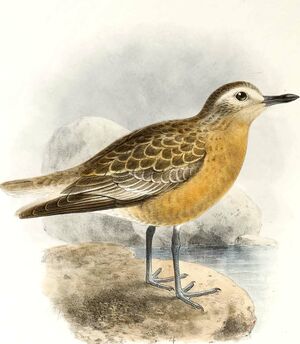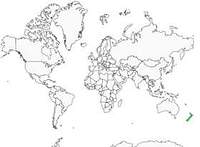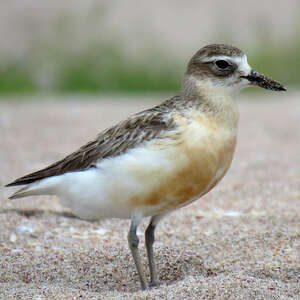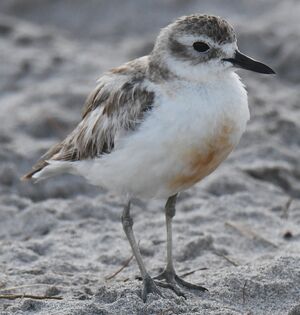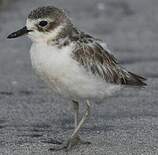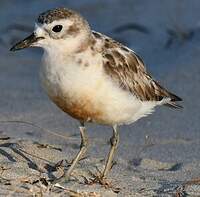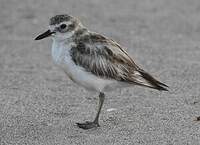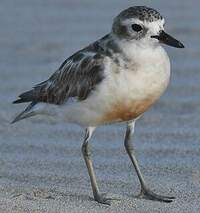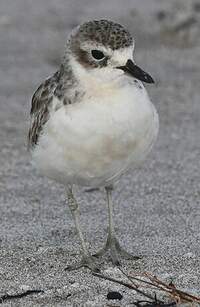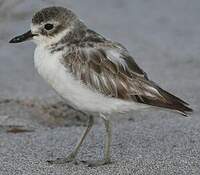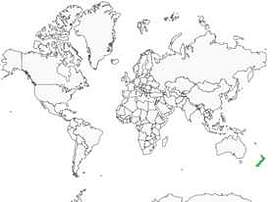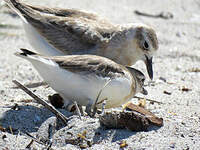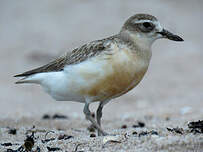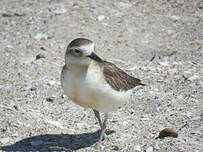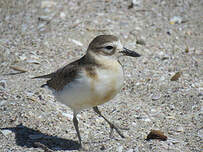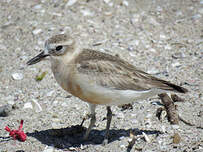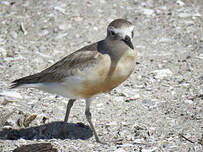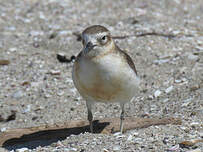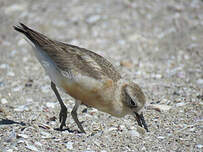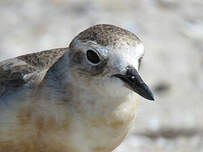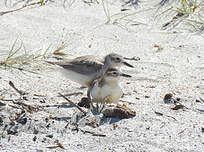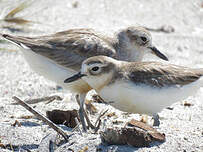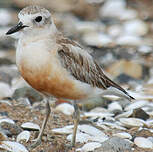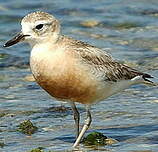New Zealand Plover
Anarhynchus obscurus - Gravelot roux Pluvier roux
Identification
The New Zealand Plover (Gravelot roux) is a large plover that could be mistaken for the turnstone (Calidris canutus), a species that winters in abundance in New Zealand. The black beak is quite long for a plover (approximately half the length of the head). During breeding plumage, the underside, from throat to belly, is orange-brown, distinctly more intense in males and the most southern birds. The upperparts are brownish, finely streaked with darker brown. The terminal lacing of feathers (remiges, scapulars and coverts) are whitish. The forehead is pale, as is the eyebrow. The eye is dark. The legs are gray-green. The juveniles are similar and have a whitish underside with a slightly darker mark on the side of the chest (much like the juvenile plovers of our lands). The upper feathers are edged with fawn instead of white. In flight, the underside of the wings is white and a broad white band crosses the upper wing.
Subspecific information 2 subspecies
- Anarhynchus obscurus obscurus (South Island. New Zealand.)
- Anarhynchus obscurus aquilonius (North Island. New Zealand.)
Foreign names
- Gravelot roux,
- Chorlito maorí de Isla Sur,
- borrelho-de-peito-vermelho,
- Maoriregenpfeifer,
- Rosse Plevier,
- Corriere pettorosso,
- maoripipare,
- Rustbuklo,
- kulík maorský,
- kulík novozélandský,
- Newzealandsk Præstekrave,
- uudenseelanninkurmitsa,
- corriol maori de l'illa Sud,
- sieweczka nowozelandzka,
- Маорийский зуёк,
- ニュージーランドチドリ,
- 新西兰鸻,
- maoripipare,
- 栗胸鴴,
Voice song and call
Habitat
The New Zealand Plover is endemic to New Zealand. Two populations are separated by a good thousand kilometers.
Behaviour character trait
Dietfeeding habits
Reproduction nesting
The breeding season of the New Zealand Plover extends from August to February. Clutch size is generally 3 eggs laid in a shallow depression in the ground. The chicks are precocial. Territory is vigorously defended against intruders, whether of the same species or not. Potential predators are also chased off.
Threats - protection
IUCN conservation status
concern
in the Wild
threatened
evaluated
As many other species endemic to New Zealand, the New Zealand Plover is threatened (classified as vulnerable by BirdLife International). It used to be widespread throughout the country. It has completely disappeared from the South Island and only occupies the extreme North of the North Island and the Stewart Island mountains. In this island, the population which had been reduced to a little over 60 individuals in the early 1990s has gradually risen to 150 individuals in 1999. This increase is due to the very important predator control efforts (cats, mustelids). In the North Island, about 1500 birds can be found. The strong decrease recorded until the mid-20th century has several causes, the main one being the introduction of terrestrial predators (a study showed that in the North Island, 60% of the nests were destroyed by predators). To which are added urbanization of some coastal sites, breeding, leisure, dogs and off-road vehicles. A captive breeding program was set up for the southern form and young ones have been raised successfully.
Sources of information
- IOC World Bird List (v14.2), Gill, F and D Donsker (Eds). 2024-04-18.
Other sources of interest
 Specification sheet created on
04/08/2023 by Georges Olioso
Specification sheet created on
04/08/2023 by Georges OliosoTranslation by AI Oiseaux.net
© 1996-2025 Oiseaux.net
- Accipitriformes
- Aegotheliformes
- Anseriformes
- Apodiformes
- Apterygiformes
- Bucerotiformes
- Caprimulgiformes
- Cariamiformes
- Casuariiformes
- Charadriiformes
- Ciconiiformes
- Coliiformes
- Columbiformes
- Coraciiformes
- Cuculiformes
- Eurypygiformes
- Falconiformes
- Galliformes
- Gaviiformes
- Gruiformes
- Leptosomiformes
- Mesitornithiformes
- Musophagiformes
- Nyctibiiformes
- Opisthocomiformes
- Otidiformes
- Passeriformes
- Pelecaniformes
- Phaethontiformes
- Phoenicopteriformes
- Piciformes
- Podargiformes
- Podicipediformes
- Procellariiformes
- Psittaciformes
- Pterocliformes
- Rheiformes
- Sphenisciformes
- Steatornithiformes
- Strigiformes
- Struthioniformes
- Suliformes
- Tinamiformes
- Trogoniformes

